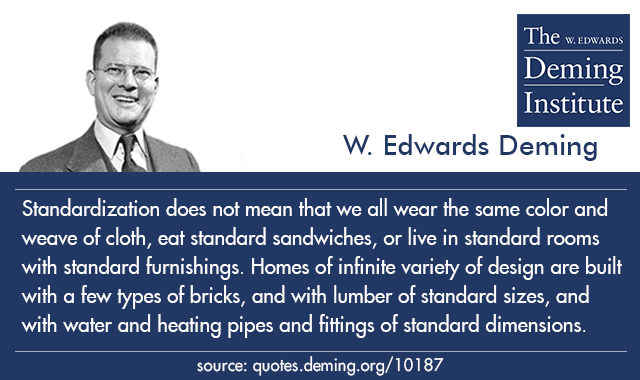Guest post by John Hunter, author of the Curious Cat Management Improvement Blog (since 2004).
We all benefit from standardization every day. We can plug our devices into a wall outlet and power them. We can get a replacement battery and have it work as expected. We can type on the keyboard without thinking because the keys are the same on each keyboard. We can connect to a new wifi network with our phone or laptop. We can buy a replacement pipe for our sink and install it.
With a systems view it is understood that there is a need to consider the entire system when designing solutions. Standardization allows us to create certainty about specific aspects of how items will interact. That certainty (of course variation still has an impact even with standardization so “certainty” may be oversimplifying it a bit) then allows us to be creative and not have to redesign every single part of a system every time we wish to improve some part of that system.
Standardization allows us to creatively improve within the context of the system and with an understanding that certain key factors will conform to those standards.
One of the objections I hear to adopting standardization is that doing so takes away our ability to be creative. This is not the case. Dr. Deming’s quote does a good job of explaining this. Standardization allows us to create systems that are reliable and effective. Within that system there should be a great deal of flexibility to apply creative ideas.
It is true organizations often impose rigid rules that restrict creativity. If standardization is responsible for part of this result then the process by which standards are created and continually improved needs to be examined. A management system needs to continually improve and part of that is continually evaluating how management concepts (such as standardization) are being applied.
Different specific instances of standardization need different levels of flexibility and ability to change over time. The way we access electricity from the walls in our buildings can have standards that are very consistent over the very long term. Other standards will be fairly frequently adjusted (often with consideration of compatibility with previous standards – backward compatibility). Internal process standards (standard work instructions) are normally best when they are continually improving. They should be designed based on this need.
Design systems so that they are reliable and allow us to creatively continually improve over time. Standardization aids this process.
Related: Standard Work Instructions are Continually Improved; They are not a Barrier to Improvement – Standardization Doesn’t Stamp Out Creativity – Interruptions Can Severely Damage Performance (design work systems with this factor in mind)



